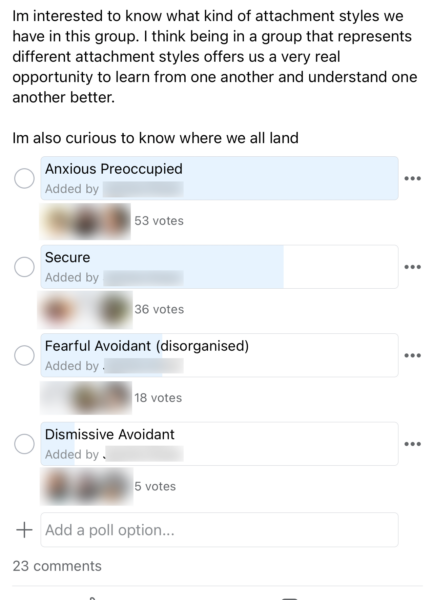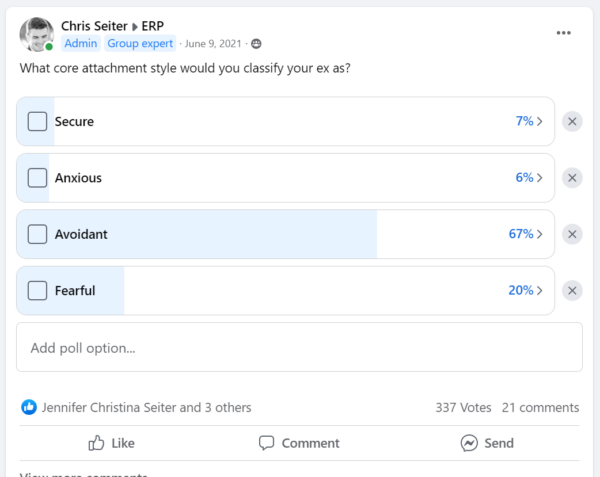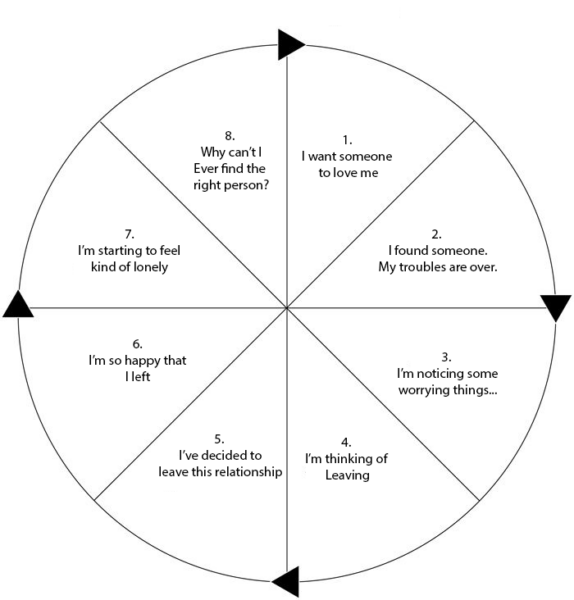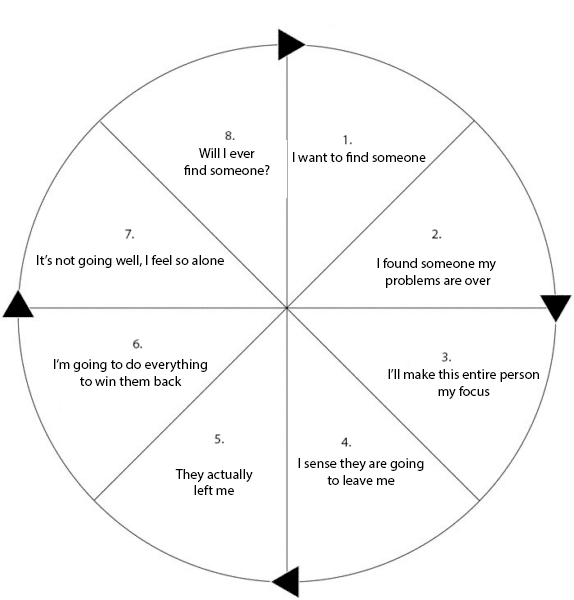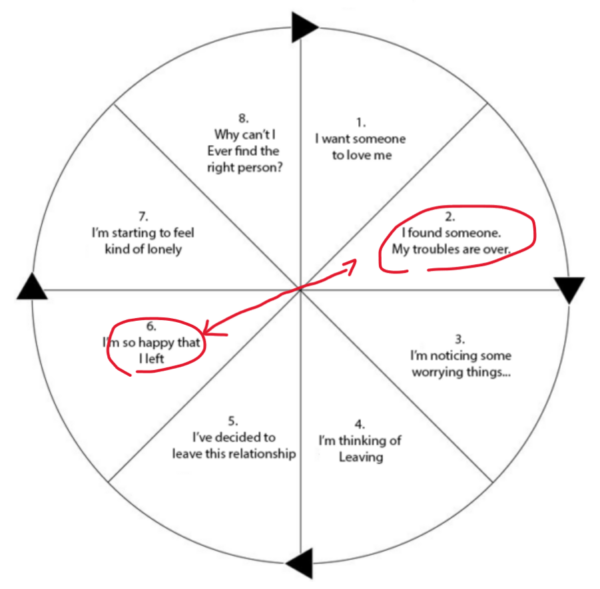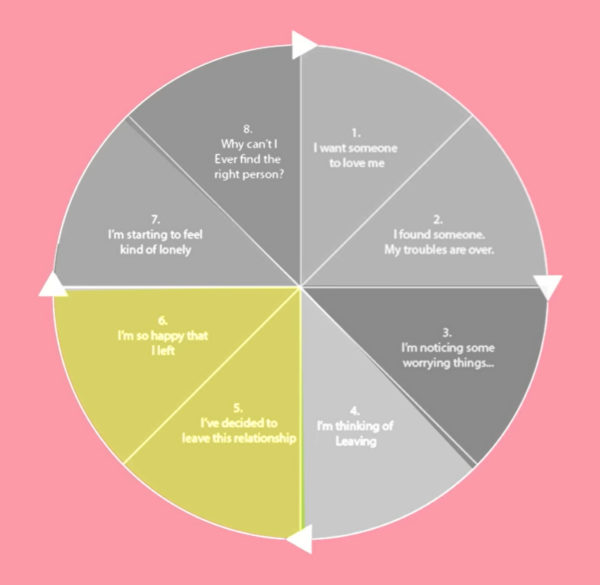Today we explore the nuanced topic of on again/off again relationships. Specifically I want to answer the question if exes can come back for a third time.
Now, I’ve been on record many times stating that one of the easiest situations to get your ex back in is with on again/off again relationships. There’s a double edged sword to it though. While it may be one of the easiest to succeed in it’s one of the hardest to stay together in.
So I thought it would be fun to take you through what the average on again/off again relationship psychology looks like.
Yep, that’ means I’ll be talking about the,
- Phenomenon of the on again/off again relationship
- The avoidant death wheel
- The anxious death wheel
- The need for honeymoon chasing
- Why a second breakup can occur
- The sunk-cost fallacy trap
There’s a lot to talk about!

What Are Your Chances of Getting Your Ex Boyfriend Back?
Take the quizThe Phenomenon Of The On Again/Off Again Relationship
I believe we should start by examining the average statistics that we encounter as a company.
Based on our internal polling, we’ve discerned that a significant portion of our clients exhibit what is termed as the “anxious attachment style.”
These tend to be individuals are profoundly consumed by the idea of reconciling with their exes. Their equilibrium seems shattered without their exes, they’re plagued by fears of abandonment, and for many, their worst nightmare has manifested.
Conversely, a majority of the ex-partners our clients aim to reconnect with display an avoidant attachment style.
These individuals are fiercely protective of their independence, often seeing themselves as ‘lone wolves’.
The intriguing aspect of this dynamic is that, paradoxically, even though they’re polar opposites, they often form long-lasting relationships. The anxious individuals, despite their dissatisfaction with the level of commitment from the avoidant partner, remain tethered by their intrinsic fears of abandonment.
Meanwhile, the avoidant individuals, who prioritize avoiding conflict, might tolerate their sense of independence being compromised just to maintain the status quo. This delicate balance persists until tensions peak and a breakup ensues.
I’m notably recognized for my extensive research on dismissive avoidant individuals. I’ve even designed an illustrative concept called “The Death Wheel” that outlines the relationship trajectory for an avoidant post-breakup.
The Avoidant Death Wheel:
This wheel encompasses eight pivotal stages:
- The desire for love and connection.
- Finding someone and believing all is well.
- Observing concerning traits or behaviors.
- Contemplating ending the relationship.
- Deciding to exit the relationship.
- Experiencing elation post-breakup.
- Feelings of loneliness begin to surface.
- Slipping into desolation, questioning their inability to find the right partner.
This cycle then resets, pushing them back to the first stage.
They become entrapped in this cyclical pattern, jumping from one relationship to another, sometimes oscillating between the same partners in on-again, off-again dynamics.
Now, it’s true that many exes we study exhibit dismissive avoidant attachment styles. We’ve dedicated a specific model to them, termed the “Avoidant Death Wheel.”
Similarly, most of our clients navigate their unique cycle, which we call the “Anxious Death Wheel.”
This can be visualized in the graphic provided.
The Anxious Death Wheel:
Mirroring the Avoidant Death Wheel, the Anxious version also comprises eight stages:

What Are Your Chances of Getting Your Ex Boyfriend Back?
Take the quiz- A yearning to connect with someone.
- Finding someone and feeling as though all their challenges have ceased.
- Channeling all their energy and focus onto their partner.
- Growing apprehension that their partner might depart.
- Facing the reality of being left.
- Resolving to go to great lengths to win their partner back.
- Struggling in their efforts and grappling with loneliness.
- Succumbing to desolation, questioning their ability to ever find the right companion.
This cycle then perpetually continues, leading them back to the outset.
An intriguing observation is when these two models—the Avoidant and Anxious Death Wheels—are juxtaposed. One can discern that many triggers in one wheel are often reflected in the other.
Transposing The Two Death Wheels On Top Of One Another Gives Insight Into How On Again/Off Again Relationships Function
- Take, for instance, stage one of both death wheels: they are fundamentally identical. Both the avoidant and anxious individuals desire love.
- In stage two, the sentiment remains consistent. Both parties find a partner and feel as though their tribulations have ended.
- However, stage three introduces a divergence. The avoidant individual starts spotting concerning issues, while the anxious person shifts their entire attention to their partner. This is the inception of their disconnect. The anxious individual, sensing an emotional gap from the avoidant, intensifies their efforts to mend the perceived rift. They incessantly seek affirmation, inadvertently alienating the avoidant individual and stoking their considerations of departure.
- Stage four crystallizes this chasm. The avoidant person contemplates leaving the relationship, whereas the anxious counterpart anticipates abandonment. Anticipating their deepest fears manifesting, the anxious person becomes desperate. They seek even more assurance, often to the point of begging and pleading. This only accelerates the avoidant’s decision to exit the relationship, culminating in stage five where the anxious person is abandoned.
- Stage six presents another deviation. For the avoidant, this is a phase of liberation and elation, akin to a second honeymoon. Free from the relationship, they feel unburdened. This phase, however, devastates the anxious person, who believes that their only recourse is to exert all efforts to win back their ex. One of two outcomes generally ensues: the anxious individual’s relentless pursuit might propel the avoidant to bypass stages seven and eight and move on, or it elongates the avoidant’s stint in stage six.
- In time, the anxious individual comes to terms with the futility of their endeavors, feeling isolated.
- Their decision to move on activates stage seven for the avoidant, who then begins to experience loneliness.
- By stage eight, both parties confront despair. The avoidant laments, “Why can’t I find the right person?” Similarly, the anxious individual wonders if they will ever find love. Their mutual despondency draws them back to each other, perpetuating the cycle.
Understanding The Avoidants Need For Honeymoon Period Chasing
From a purely dismissive avoidant perspective, these relationships often revolve around what I term “honeymoon period chasing”.
The dismissive avoidant experiences a honeymoon, or at least a mini honeymoon period, in stage six.
Interestingly, a parallel honeymoon period is also observed in stage two of their death wheel. Avoidants gravitate towards honeymoon phases, primarily because it doesn’t demand profound commitments like marriage or cohabitation.
It’s a period of unhurried enjoyment, an ideal scenario for an avoidant: retaining independence while reaping all relational benefits.
However, a distinct aspect of avoidants is their dual experience of the honeymoon phase—once in stage two and again in stage six, post the breakup. Their cyclical motion through the death wheel can often be attributed to this incessant chase of the honeymoon phase. They might reconcile, anticipating another honeymoon, but subconsciously they might also foresee an eventual relationship demise, thus craving another honeymoon period.
Complicating matters, anxious individuals often exhibit codependent traits.
They become singularly fixated on their partner, experiencing a form of tunnel vision.
To illustrate, while watching an old episode of “The Bachelor in Paradise”, my wife and I noticed a contestant entirely smitten with a man who didn’t reciprocate with equal intensity.
He, being avoidant, provided ample subtle indications of his disinterest, but she couldn’t grasp them until a more overt act—the refusal of a rose—occurred.
Yet, even then, her understanding was muddled, an evident display of her anxiety and probable codependency. Such instances, albeit on a smaller scale, mirror the broader dynamics of on-again, off-again relationships. It’s a dance of two: the avoidant exploits in one manner, while the anxious, with their skewed perspective, does so in another.
Instead of fostering an interdependent relationship, which is the healthier goal, they unknowingly sustain a codependent dynamic that hinges on mutual neediness.
The Second Breakup Can Occur For A Host Of Reasons
- Nature of Unresolved Issues: Most couples who reunite often do so without fully addressing the core issues that led to their initial breakup. These unresolved issues can be related to trust, communication gaps, differences in life goals, infidelity, or personal habits.
- Triggers and Memory: Even after reconciliation, certain triggers (like an argument topic, a place, or an incident) can bring back painful memories of past issues. This can lead to heightened emotional responses and disputes, even if the triggering event itself is minor.
- Emotional Baggage and Defense Mechanisms: Due to past hurt, individuals might develop defense mechanisms or emotional walls. They might be quicker to become defensive, less patient, or more suspicious based on prior experiences. This can hinder effective communication and understanding.
- The Cycle of Repetition: Some couples fall into a repetitive cycle, where they keep facing the same issues without ever truly resolving them. This can lead to feelings of frustration, hopelessness, and resentment. Each repeated issue can intensify these feelings, making the relationship increasingly strained.
- Expectations vs. Reality: After a reunion, there might be heightened expectations that things will be better this time around. However, if past issues resurface, the gap between these expectations and reality can lead to profound disappointment.
- The Difficulty in Seeking Help: Some couples feel embarrassed or believe they can manage their problems themselves, especially since they’ve already broken up once. They might be hesitant to seek counseling or therapy, thinking it’s an admission of failure. This reluctance can prevent them from obtaining the tools and insights they need to overcome recurring issues.
- The Impact of External Influences: Friends and family, who might have been supportive during the initial breakup, could become skeptical or critical if they see the same issues arising again. Their doubts and concerns can add external pressure on the relationship.
- The Illusion of Change: Sometimes, in the honeymoon phase of a reunion, it might seem like issues have disappeared or that both partners have changed. However, without genuine growth, reflection, and effort, the same problems can easily come back.
- Effort Imbalance: If only one partner acknowledges and works on past issues, while the other remains in denial or is dismissive, it can lead to an imbalance in efforts. This can further strain the relationship, making the same problems feel even more insurmountable.
- The Importance of Closure: If past issues keep resurfacing, it indicates a lack of closure. Without closure, it’s challenging to move forward and build a healthy relationship foundation.
Then the avoidant individual basks in their newfound freedom via the separation elation phase,
And readies themselves for the cycle to repeat again.
The “Sunk Cost” Fallacy Trap
First things first, what is the “sunk cost” fallacy?
Well, here’s a fun little video on it,
Here’s the official definition,
The “sunk cost fallacy” is a cognitive bias where individuals continue a behavior or endeavor based on previously invested resources (like time, money, or effort) rather than on the current and future value of the outcome. It’s the idea of “throwing good money after bad” or continuing a behavior simply because of the investment made, even if it doesn’t serve one’s best interests.
A lot of what’s happening in these on again-off again relationships is happening because of the sunk cost fallacy. You get trapped in this on again/off again cycle under the hopes that your time won’t be wasted or that things will eventually change.

What Are Your Chances of Getting Your Ex Boyfriend Back?
Take the quizIn the context of relationships here are some of the most common sunk cost fallacy “reasonings,”
- Time Investment: In relationships, time is a significant resource. Individuals might think, “We’ve been together for X years; we can’t give up now.” This mindset can lead them to stay in or return to a relationship, even if it’s not beneficial or healthy, just because they feel they’ve invested a lot of time.
- Emotional Investment: The emotional energy, effort, and memories created in a relationship can make individuals feel that they’ve invested too much to let go. They might hope that things will improve in the future because of the emotions they’ve poured into the relationship in the past.
- Shared Experiences: Having weathered challenges, celebrated milestones, or even faced traumas together can make individuals feel they’ve invested too much in the relationship to walk away, even if the relationship itself is no longer fulfilling.
- Fear of Regret: The thought of potentially regretting the decision to part ways can be daunting. People might fear that they’ll later view the breakup as a mistake, especially considering the investment they’ve made in the relationship.
- External Investments: This can include shared assets, friends, or even children. The complexity of untangling these shared investments can push individuals to stay in or return to a relationship based on the perceived difficulty of separating these shared aspects of life.
- Comparison to Others: If individuals perceive their relationship’s length or challenges as more significant than those of others (e.g., thinking, “We’ve been through more than most couples”), they might feel compelled to continue investing in the relationship based on the belief that they’ve overcome so much already.
- Belief in Turnaround: Much like an investor hoping that a declining stock will rebound, individuals might hope that if they just invest a bit more time, effort, or patience, the relationship will improve. This can lead them to overlook present issues in favor of a potentially brighter future.
- Avoiding Admitting “Failure”: Some people view the end of a relationship as a failure, especially if they’ve invested heavily in it. This can push them to continue or re-enter the relationship to avoid the feeling or perception of failure.
